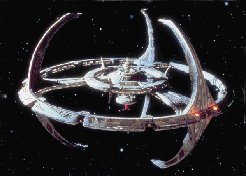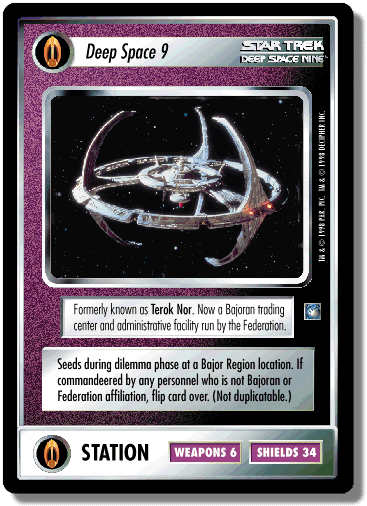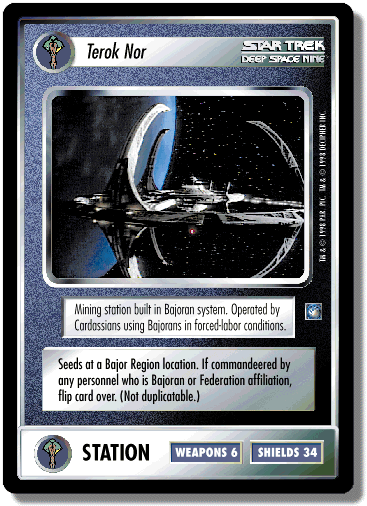
The release of the expansion September of 1998
represented the biggest add-on of cards at that time. This stand-alone expansion
brought many new, exciting elements into the STCCG environmnet, along with a
wealth of new playing concepts and deck themes. Also, it added new card types
and expanded on others. Following is a list of the big additions this large
expansion as brought.
~Two new affiliations: Bajorans and Cardassians--It may be thought of as
difficult to fit in two whole affiliations in one expansion and balance them out
while still paying attention to other affiliations, but Decipher has done a
wonderful job. Both of these new affiliations have their strengths and weaknesses
and can be a new surprise to conservative players.

~Facilities: space stations and headquarters--The space station was almost
assumed to have been included in this set, as Deep Space Nine is set on a station.
The amazing effects that the station has on the entire game is what is exciting.
It offers a whole new approach to the game and many new strategies. The Nor is the common space station anyone can use, but it starts out Cardassian. While Nors are not strong offensively for battle, it takes a lot to bring them down. Headquarters also add strengths to a deck and can be the center of deck themes. Other cards with "HQ" in the title can be used in combination as well.
~New card type: Site--Site cards are the "customizable" part of Nors, in
essense the rooms on the stations where the personnel are located. Each site offers
their own bonuses and place on the station, and are the only ways for people, ship, and equipment to report aboard (traditionally). But remember that anyone can be on
a space station at any time, so the advantages could go either way. Any player can seed sites to any player's Nor, making defensive strategies essential to a Nor player. Control of a station--and thus its advantages--could be lost quickly and permanently if a player isn't careful.
~Delta Quadrant--With Deep Space Nine comes the Wormhold, which allows easy travel to the Delta Quadrant for everyone. The DS9 expansion contains a number of missions that are seeded in the Delta Quadrant, which is not connected to the Alpha Quadrant space line. Delta Quadrant missions form their own, separate space line, but can be reached through irregular means, such as the Bajoran Wormhole, or other cards that can move a ship other than by normal means. The only thing is, if you find a way to get there, make sure you can get back! :)
~Tougher dilemmas--The more than dozen new dilemmas that are introduced in DS9 bring out more challenges than previous cards. Some less-common skills, such as biology and geology, are used and more cards are aimed at stopping personnel if they aren't killed. This can lead to more involvement with the opponent and more battles. It is now even more wise to include more than one Scan card in your deck and a balanced Q's Tent. Also, players would be wise to have a healthy stock of weapons to protect away teams and crew.
~Altered battle rules--To make opposition more effective, away team battles were changed and made slightly random, as casualties in battle actually ends up being more random than not. Both players face off each of their personnel, one-on-one, to weed out "stunned" and "mortally wounded" personnel. Weapons have an amazing advantage for this purpose, and so now have added value. After all of one's personnel have been faced, then all of the standing bodies are counted to make one final kill, as was the case in the rules before. It is therefor all the more necessary to be wary of the opponent's position when venturing out with very weak personnel that have key skills.
RULES:The seeding requirements were changed, as were the deck size limits. Missions are now seeded for free, and all seed cards still can't total over 30. BUT, your draw deck's only limit is a minimum of 30 cards--no upper limit! Also, other cards types, such as events for treaties, are seedable, which is very cool. This no longer hampers many themes. Also ammended with the rule change was that BOTH players' draw decks must be depleted to end the game.
![]()

Please send any comments, questions, or ideas to honestal23@yahoo.com. What card would you like to be featured next? Do you have any deck themes?


Last updated:7-31-02
Links
My Star Trek CCG Page (menu)
My Nor/Cardassian Deck